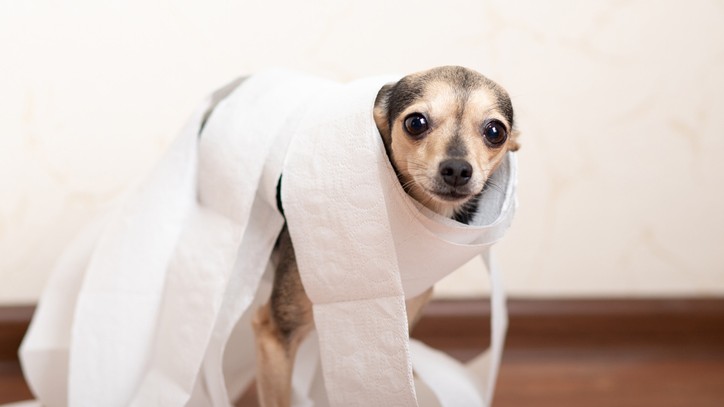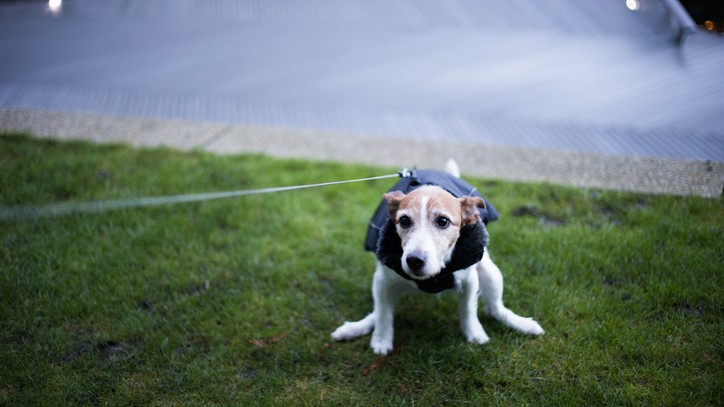A vet’s guide to dog constipation
Dog constipation can be a strain, and not just for your dog! So why does it happen and what can be done?

As a pet parent, you get to know your furry friend's routine, and if you notice that your dog has constipation it can be a real worry. If your dog is constipated, you’ll probably notice them straining and passing less poop, as well as spotting that the poop that they do manage to pass is smaller, harder, and drier than normal.
As a vet with nearly ten years’ experience, I come across pooches with poop problems regularly, and the information below should help you understand the condition, as well as why it happens and what can be done to treat it.
- A vet's guide to Osteoarthritis in cats
- A vet’s guide to Parvovirus in puppies
- How to help a dog with diarrhoea
What is constipation?
Constipation occurs when faecal output is less than normal or absent completely. Dry or firm feces can move more slowly through the large bowel, and require effort to pass, leading to straining and discomfort. Sometimes, a fecal motion becomes so dry and difficult to pass that it forms a complete blockage of the large bowel, and more and more fecal matter builds up behind it. The straining caused by constipation can sometimes lead to affected dogs passing small amounts of blood or mucus, and in severe cases, dogs can develop vomiting if the gut blockage is not dealt with quickly.
How do dogs get constipation?
Constipation can happen for several reasons. The simplest reason is a change in their food or a reduction in water intake. If your dog suddenly drinks less, or their diet is changed from wet food to dry dog food, they can become less well hydrated. Equally, if they are changed to a diet that is lower in fiber, their feces is less able to take on water, and so they can become bunged up with drier feces. This becomes a vicious cycle since the longer feces spends in the large bowel, the more water is absorbed from it, and the drier it becomes. In time, it becomes harder and harder to pass and causes a blockage.
Dogs can also become constipated if they have eaten bones or other foreign or undigestible material. Sometimes, these foreign bodies can pass through most of the guts with no problem, but get lodged in the large bowel, where they obstruct the feces.
Finally, dogs can also become constipated if they find passing poo painful. For example, if they have an anal gland infection, sore skin, spinal pain, or tight mats of hair around their bottom, they may resist the urge to pass feces because it hurts. Over time the feces sitting in the large bowel becomes dry and firm and this leads to constipation.
Symptoms of constipation in dogs
Dogs who are constipated can show the following symptoms:
Get the best advice, tips and top tech for your beloved Pets
- Straining to pass feces
- Multiple attempts to pass feces, with nothing produced
- Passing small amounts of hard, dry, feces
- Fecal material may be coated by a film of mucous
- Small amounts of blood or mucous may be passed during straining
- Licking around their bottom
- Bloated abdomen (in severe cases)
- Vomiting (in very severe cases)
Treating constipation

There’s no NHS for pets. Veterinary care can be eye-wateringly expensive and most pets will need treatment for an illness or injury at some point in their life. It’s difficult to think about your animals being hurt or unwell, but you need to ask yourself: what would you do if you were faced with a vet bill for hundreds or thousands of pounds?
In mild cases, constipation can be treated by ensuring good hydration by offering water freely or even adding additional water to dog food. However, this is only successful in very mild cases. If your dog does not quickly start passing feces, your vet will likely prescribe lactulose or another similar medication. The purpose of lactulose is to lubricate the stools to allow easier passage through the guts.
If your dog has a blockage from constipation, your vet will likely be able to feel this. In these cases, an enema is usually required, where a lubricant and water solution is passed up your dog's bottom to the area of the blockage. This can be performed with or without an anaesthetic or sedation. However, anaesthetic is often used so that the dry fecal material can be broken up using abdominal massage. Your vet may also give your dog fluids via a drip before and during the enema, to try to hydrate the dry feces, making it easier to remove.

Tips on preventing constipation
The best way to help prevent your dog from suffering from constipation is to keep drinking water freely available, perhaps consider a pet water fountain, and keep their diet consistent. If you have to change their diet for a particular reason, try to stick to the same type of food. For example, if your dog normally has the best wet dog food it would be best to select another wet food, or if this is not an option, be prepared to provide additional water and encourage them to drink it.
You should never feed your dog bones or other objects that may not be digestible and could cause a gut blockage. Even if your dog has eaten bones with no problems before, they could still develop an obstruction.
Keep your dog’s back end clean and the hair short, with regular grooming, and keep an eye out for any signs of licking or dragging their bottom, as this might be a sign of full anal glands or irritation.
Conclusion
Constipation is an unpleasant problem, but luckily by controlling your dog's diet and water intake, and keeping them well-groomed, it is often quite avoidable. If your dog does develop constipation, make an appointment with your vet, who will hopefully be able to get them back to their regular self in no time!
Dr Hannah Godfrey is a small animal vet who graduated from the Royal Veterinary College in 2011 and began work straight away at a busy mixed practice. Initially, she treated all species, but focussed on small animals from 2014. She has a passion for soft tissue surgery, ultrasound, and canine and feline dentistry, having completed additional training in these areas.

